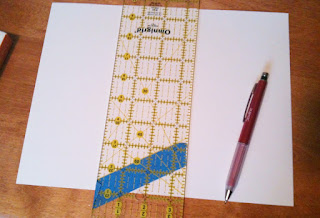I'm getting excited about my trip to San Francisco, and getting ready to kick off a little quilt along. Here's a tutorial for a simple sewing kit geared toward the English paper piecer. It's got a little stiffness. It's got two big pockets in case you're working on something large. It closes easily with an elastic band. It's quick to make.
The size is a bit arbitrary, based on the interfacing I had available. But since it's basically just a double sided piece of fabric folded in at the ends, you could adapt it to whatever size you want. I have been using this all week though and it is working well.
In mine I included a little tin with essential supplies. I epoxied a bit of felt on the inside for my needles and pins. A spool won't fit in this tin but it's perfect for bobbins. Also included is a thread cutter for airport-security-approved sewing. You could use nail clippers instead if you don't have a thread cutter.
Gonna make one? You need:
Outer and lining fabrics: 29 1/2'' x 10''
Small elastic hair band
Button (thrilled to finally have a use for this awesome vintage button)
Stiff interfacing: 2 pieces 7 x 8.5. I used
Fast 2 Fuse, because I had it. You could also use something like
Timtex. Or just cut up a cereal box. No biggie. You just want a little structure in there.
I have only a few pictures here. The thread I used is the
exact same color as my linen so it was hard to see and therefore pointless to photograph. Luckily, this project is dead simple even without pictures.
1. Lay your outer and lining fabrics right side together. Sew both the long sides and one short side with a 1/4'' seam. Leave the other short side completely open.
2. Clip the corners, then turn right side out and press the edges.
3. From the finished short edge, mark a line 6 1/2'' in on the lining side. Stitch along this line. Insert a piece of interfacing.
4. From the last line you stitched, mark a line 7 1/2'' in. Mark another line 1/2'' from that. Stitch along both these lines. Insert the other piece of interfacing.
5. From the last line you stitched, mark a line 7 1/2'' in. Stitch along this line.
6. Turn in the open side of the pouch 1/2'' and press. Topstitch this edge closed. Topstitch the other short edge too, so it matches. If you used a fusible interfacing you can fuse it now.
7. Figure out which side you want to be the back. Attach your elastic band to the middle of the back side stitching line with a zig zag stitch. It should point toward the center lines.
8. Fold in both short edges along the lines of stitching. Press. Pin/clip and topstitch around the entire pouch. Add the button wherever it needs to go based on the button and elastic hair band size.
I like that I can fold it back on itself for a smaller footprint. I like that it looks simple and not overwhelming visually.
I've used this over the week to stitch at work and at home during a occasional slow moments. It's nice to get a little sewing time even when I can't possibly be at my machine!















































